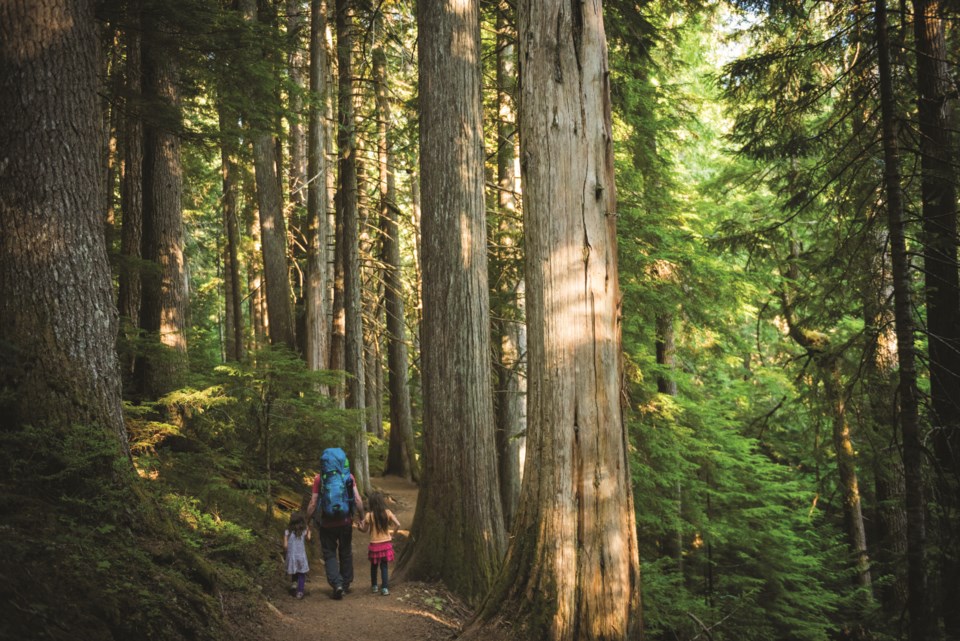Trees are powerful players in the fight against climate change, serving as “carbon sinks” that pull greenhouse gas (GHG) emissions out of the atmosphere and improve air quality—but with lumber prices on the rise in recent years, that doesn’t mean they’re priceless.
In terms of dollars, just how valuable is Whistler’s temperate rainforest standing?
That’s one question Whistler-based graduate student Jared Areshenkoff sought to answer through his recent master’s research for Royal Roads University. As part of his research, Areshenkoff evaluated how much carbon the Resort Municipality of Whistler's (RMOW) trees can effectively store, based on the pollutant’s current and future market price. His research focused on above-ground biomass—so branches, stems, foliage and bark—located within the resort’s boundaries.
“Nearly everything that is considered in today’s world is typically viewed from an economic lens, including the steps needed for climate change mitigation. I wanted to use that same argument in order to put a value on trees within the RMOW that doesn’t include lumber value,” he explained in an email.
“Essentially, what this research is about is providing another argument for protection,” he added in a follow-up conversation.
As Areshenkoff discovered, Whistler’s trees are significantly undervalued.
The resort lies within the Cheakamus Community Forest (CCF), one of more than 60 community forests across B.C. that already assigns a value to forest carbon and sells it in the form of offsets. Since 2015, the CCF has offered the verified credits to individuals or groups looking for a way to compensate for their GHG emissions, with prices set by the province. The offsets brought in an average of around $100,000 for the CCF annually, as of 2021.
Areshenkoff used both quantitative (numbers-based) and qualitative (interpretation-based) data analysis throughout the year-and-a-half-long research project to first figure out just how many trees are located in Whistler. Then, he used software called i-Tree to determine a monetary value for the pollutants those trees remove from the atmosphere.
The researcher determined that 68.53 per cent of the RMOW is forested. Leaning on a normalized set of carbon sequestration and storage values for specific tree species, he was able to determine that Whistler’s above-ground biomass removes approximately 208.16 kilotons of carbon dioxide equivalent (CO2e) each year.
“As far as how much carbon is actually being sequestered and stored on an annual basis, this is essentially new research,” he said.
Currently, the province prices carbon at $50 per tonne, a number that’s set to rise by $15 each year until it reaches $170/tCO2e by 2030.
At carbon’s current price, Areshenkoff’s research shows Whistler’s trees—without accounting for below-ground biomass like roots—should be valued at nearly $10.5 million. “This, of course, will increase annually based on the price of CO2e at roughly $3 [million] per year,” he added.
Keeping in mind the CCF overlaps Whistler’s boundaries, Areshenkoff said the CCF currently sells carbon offsets at a rate of $25t/CO2e—meaning its current carbon forest structure is valued “far below B.C.’s price on pollution.”
When confronted with the difference “between what the province values forest carbon within the CCF at, roughly $100,000 a year, versus what my research indicated, at, like, $12.5 million, it was surprising, honestly, for me to find out that my research is accurate; my population data sets are accurate,” he said.
Incorporating research like Areshenkoff’s into future evaluations could eventually mean a decrease in the number of trees cut down for lumber each year. (With little commercially viable old growth left, the CCF board in March decided to defer old-growth logging for the remainder of the year while it looked to diversify its revenue stream.)
Trees shouldn’t just be valued for their carbon-capturing abilities, but for their other “ecosystem services,” Areshenkoff continued. In other words, that means trees’ positive effects on biodiversity, soil and slope stability, wildfire mitigation and psychological well-being of humans who walk among them.
The benefits to assessing nature’s dollar value in these terms “are huge,” Areshenkoff noted, but carbon sequestration and storage values are an easier place to start because CO2e already has a definitive market price. Especially if the other above-named ecosystem services were fully captured, “the benefits to protecting the trees would far outweigh any merchantable value they have” as lumber, he added.
Now with his thesis completed, Areshenkoff said he is currently working with the municipal government to create “tree tags” that will eventually be posted throughout the village.
“They’ll say this Douglas fir, or this hemlock at full age of, say, 150 years, is worth $15,000 in lumber value, but when accounting for all the ecosystem services, including carbon sequestration, cooling effects, cultural values, etc., this tree is actually worth in the range of $65,000,” he explained.
“I think it’ll be a really good tool for not only tourists, but all of us locals to walk around the village and be like, ‘Wow, I didn’t really realize that this tree held such economic value aside from its lumber value.'”
It seems Areshenkoff’s research is coming at the right time: It aligns with a project looking to assign value to Whistler’s natural assets that was OK’d by Whistler council on July 19.
That project will be operated through the Municipal Natural Assets Initiative (MNAI), an organization that works with municipalities to quantify the value provided to local government by ecosystems and natural resources like forests, wetlands, drinking water, ski terrain and trail systems.
Though Areshenkoff admitted he’s far from the first to complete carbon registry work, what his research has found is just how “severely undervalued” the current carbon storage numbers are.
“That’s one of the main problems, is that we’re undervaluing it so much that it’s not creating that incentive to protect it,” he said. “It’s just so, so important to remember that these ecosystems can self-regulate and thrive without human intervention, but they can also coexist and coexist if they’re protected and managed properly.”





